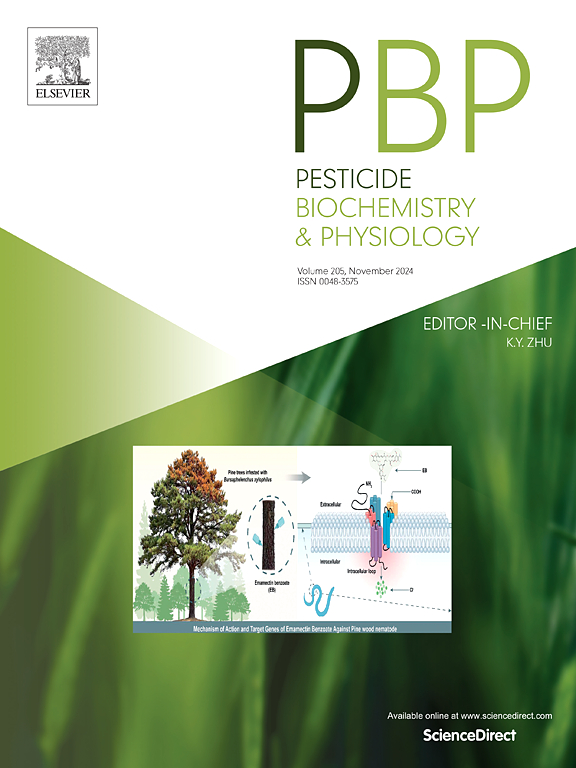Ecotoxicological effects of the neonicotinoid insecticide dinotefuran on springtails (Folsomia candida) at soil residual concentration
IF 4.2
1区 农林科学
Q2 BIOCHEMISTRY & MOLECULAR BIOLOGY
引用次数: 0
Abstract
Dinotefuran, a third-generation neonicotinoid insecticide, is widely used in agriculture production due to its excellent insecticidal efficacy. Considering its persistence and high toxicity in soil, it is essential to evaluate its low-dose toxic effects on non-target soil organisms such as the springtail (Folsomia candida). The results revealed that the 7-day half lethal concentration (7d-LC50) of dinotefuran contact toxicity to springtails was 0.029 μg cm−2. Its chronic toxicity in 4 soil types was ranked as: red soil (0.021 mg kg−1) > fluvo-aquic soil (0.040 mg kg−1) > artificial soil (0.049 mg kg−1) > black soil (0.085 mg kg−1). Soil organic matter (SOC), pH, and total nitrogen (TN) were identified as critical factors affecting dinotefuran toxicity. Biochemical assay results showed that environmental concentrations (0.2–1.6 mg kg−1) of dinotefuran induced oxidative stress and oxidative damage in springtails. Oxidative stress-related enzymes (including superoxide dismutase (SOD) and catalase (CAT)) and detoxification enzymes were subjected to initial activation at low dinotefuran concentrations, inhibition and re-activation at high concentration. Target enzyme acetylcholinesterase (AChE), malondialdehyde (MDA) content, and total protein content were inhibited with prolonged exposure time and increasing concentrations of dinotefuran. Molecular docking analysis showed that dinotefuran bound to the active sites of related enzymes, thus disrupting their structure and functions, eventually resulting in damages to physiological functions of springtails. In summary, this study deciphers the dinotefuran toxicological mechanism on soil springtails at environmental concentrations. Our findings lay theoretical basis for further assessing its pollution risk and managing its application.

新烟碱类杀虫剂呋虫胺在土壤残留浓度下对假丝虫的生态毒理学效应
呋虫胺是第三代新烟碱类杀虫剂,因其优异的杀虫效果而广泛应用于农业生产。考虑到其在土壤中的持久性和高毒性,有必要评估其对假丝虫等非目标土壤生物的低剂量毒性作用。结果表明,呋虫胺对弹尾虫的7天半致死浓度(7d-LC50)为0.029 μ cm−2。其在4种土壤类型中的慢性毒性排序为:红壤(0.021 mg kg−1);潮土(0.040 mg kg - 1) >;人工土壤(0.049 mg kg - 1) >;黑土(0.085 mg kg−1)。土壤有机质(SOC)、pH和总氮(TN)是影响呋草胺毒性的关键因素。结果表明,环境浓度(0.2 ~ 1.6 mg kg−1)的呋虫胺可诱导弹跳虫氧化应激和氧化损伤。氧化应激相关酶(包括超氧化物歧化酶(SOD)和过氧化氢酶(CAT))和解毒酶在低浓度时经历初始激活,高浓度时经历抑制和再激活。靶酶乙酰胆碱酯酶(AChE)、丙二醛(MDA)含量和总蛋白含量随着暴露时间的延长和浓度的增加而受到抑制。分子对接分析表明,呋虫胺与相关酶的活性位点结合,从而破坏了相关酶的结构和功能,最终导致弹尾虫生理功能受损。综上所述,本研究揭示了环境浓度下呋虫胺对土壤跳虫的毒理学机制。研究结果为进一步评价其污染风险和管理其应用奠定了理论基础。
本文章由计算机程序翻译,如有差异,请以英文原文为准。
求助全文
约1分钟内获得全文
求助全文
来源期刊
CiteScore
7.00
自引率
8.50%
发文量
238
审稿时长
4.2 months
期刊介绍:
Pesticide Biochemistry and Physiology publishes original scientific articles pertaining to the mode of action of plant protection agents such as insecticides, fungicides, herbicides, and similar compounds, including nonlethal pest control agents, biosynthesis of pheromones, hormones, and plant resistance agents. Manuscripts may include a biochemical, physiological, or molecular study for an understanding of comparative toxicology or selective toxicity of both target and nontarget organisms. Particular interest will be given to studies on the molecular biology of pest control, toxicology, and pesticide resistance.
Research Areas Emphasized Include the Biochemistry and Physiology of:
• Comparative toxicity
• Mode of action
• Pathophysiology
• Plant growth regulators
• Resistance
• Other effects of pesticides on both parasites and hosts.

 求助内容:
求助内容: 应助结果提醒方式:
应助结果提醒方式:


